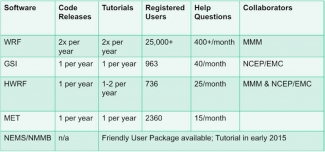One function of the DTC has been to archive and maintain important model-related code, and to make it available to operational and research segments of the meteorological community. As Laurie Carson describes it, the code maintenance and support function has important objectives in both O2R and R2O arenas: for the former, providing operational software to the research community, and for the latter, facilitating transfer of research capabilities to operational software packages. DTC’s approach is based on a philosophy that community software is a resource shared with a broad community of (distributed) developers specifically including the capabilities of operational systems. Two keys to its success are periodic public releases that include new capabilities and techniques, and effective user support. The chart summarizes present and planned DTC software support activities in five principal areas: WRF model updates and support, data assimilation (GSI) code releases and support, the end-to-end operational hurricane forecast system (HWRF), verification package maintenance and support (MET), and planning for a future community package of the NOAA Environmental Modeling System (NEMS) that includes the NMMB model. Some community code now supported in this way has derived from DTC visitor projects; an example is the field alignment technique described in the 2012 visitor project of Sai Ravela (summary available at http://www.dtcenter. org/visitors/year_archive/2012/). For further description of the DTC community software efforts, see http://www. dtcenter.org/code/.
As the chart indicates, another community outreach-related DTC activity involves arranging and contributing to workshops and tutorials to facilitate use of these community model and analysis packages. A future issue of Transitions will summarize recent and upcoming events of this kind.

